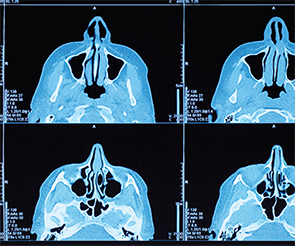
Image Credit: Viktor Gladkov/SHUTTERSTOCK.com
DALLAS—A 37-year-old woman presents with nasal airway obstruction that’s worse on the left, when lying down, and in cold air. Over the past three months, she has tried over-the-counter medications and a steroid nasal spray, with some improvement.
Explore This Issue
November 2015An exam shows that the septum is deviated to the left. Now, questions arise: Do you need to perform a CT scan to document the deviation? How long does she need to try nasal spray before moving on to surgery? What do you need to give the insurer for prior authorization?
These and other questions have been addressed in a new Clinical Consensus Statement on septoplasty from the Academy of Otolaryngology–Head and Neck Surgery (AAO-HNS). The major points of the statement, which offers 20 comments regarding imaging, medical management, and perioperative considerations for septoplasty, were discussed in a session during the annual meeting of the AAO-HNS Foundation, held in Dallas September 27-30.
Performing Nasal Endoscopy with Nasal Obstruction
Scott Stringer, MD, MS, chair of otolaryngology and communicative sciences at the University of Mississippi in Jackson, said he performs nasal endoscopy in cases of a deviated nasal septum approximately three-quarters of the time. “Situations where I would not do it is if the history is crystal clear, [and] there’s nothing unusual whatsoever,” he said.
Timothy Lian, MD, vice chair of otolaryngology at Louisiana State University in Shreveport, said that he performs endoscopy for a deviation approximately 50% to 75% of the time, although he noted that his cases are skewed toward plastic and reconstructive procedures. He added that he would perform nasal endoscopy if he couldn’t explain elements of the history provided by the patient.
The statement also points out that endoscopy could provide “useful information” even when the deviation can be plainly seen. That could help with insurance resistance on coverage of the endoscopy, said Richard Rosenfeld, MD, MPH, senior advisor for guidelines and quality at the AAO-HNS, because physicians can now point to the statement.
CT to Document a Septal Deviation
If a CT is ordered purely to demonstrate the septal deviation, the vast majority of the statement panel members did not think it was a necessary step, Dr. Stringer said. On the other hand, certain carriers might require the scan in certain cases. Dr. Rosenfeld pointed out that the lack of support for performing a CT scan to establish that a deviation exists was partially due to the drawbacks—it’s costly, it might not be readily accessible, and it involves exposing patients to radiation.
Medical Management with Nasal Sprays before Septoplasty

Image Credit: Creations Naumov/SHUTTERSTOCK.com